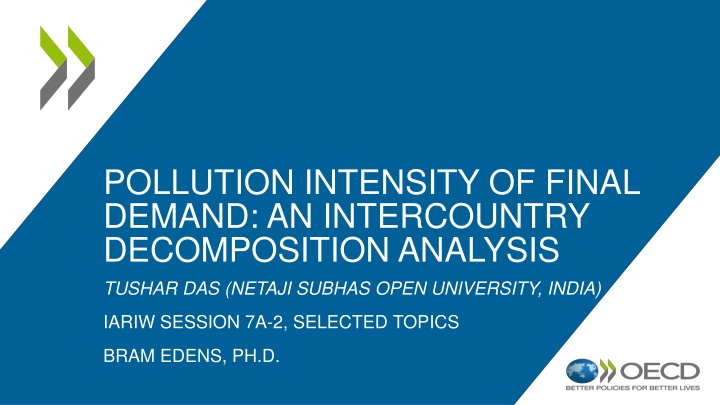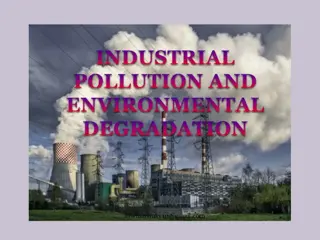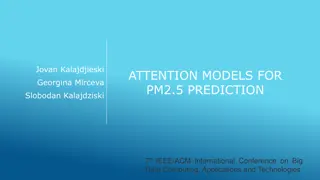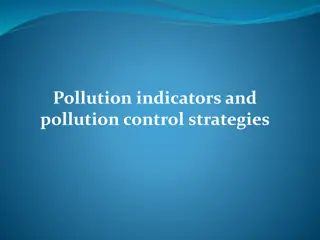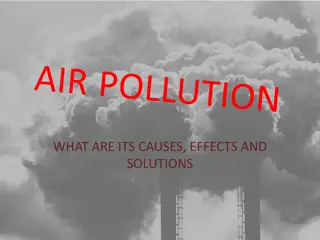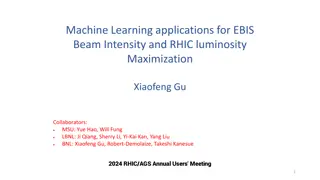Pollution Intensity of Final Demand: An Intercountry Decomposition Analysis
Environmental pollution is a significant concern resulting from economic development, particularly in countries like India, China, and Japan. This research focuses on analyzing the pollution effects of economic activities and offers policy implications to minimize pollution while promoting growth. The study uses input-output models to understand the pollution intensity of final demand and explores intercountry differences in pollution coefficients.
Uploaded on Mar 16, 2025 | 1 Views
Download Presentation

Please find below an Image/Link to download the presentation.
The content on the website is provided AS IS for your information and personal use only. It may not be sold, licensed, or shared on other websites without obtaining consent from the author.If you encounter any issues during the download, it is possible that the publisher has removed the file from their server.
You are allowed to download the files provided on this website for personal or commercial use, subject to the condition that they are used lawfully. All files are the property of their respective owners.
The content on the website is provided AS IS for your information and personal use only. It may not be sold, licensed, or shared on other websites without obtaining consent from the author.
E N D
Presentation Transcript
POLLUTION INTENSITY OF FINAL DEMAND: AN INTERCOUNTRY DECOMPOSITION ANALYSIS TUSHAR DAS (NETAJI SUBHAS OPEN UNIVERSITY, INDIA) IARIW SESSION 7A-2, SELECTED TOPICS BRAM EDENS, PH.D.
Outline Objective Methods and data sources Results Conclusions Suggestions Unclassified - Non classifi
Objective Motivation: Environmental Pollution is, no doubt, a byproduct of economic development process in general and of industrialisation in particular. In India , China and Japan domestic energy consumption ( Rural and Urban ) is responsible for a significant percent of carbon emission frequently unnoticed and too often disregarded. The existing economic literature regarding the environmental consequences of final demand is very limited. Goal: Resorting to an input-output framework, this paper aims to capture the direct, indirect and induced pollution effect of economic activity/activities in a sector through its repercussion on other related economic activities. Fill gaps in the empirical literature and through interpretation of results obtain some useful policy implications regarding any trade / domestic investment policy compatible with the growth and distribution objective on the one hand and minimization of pollution on the other Unclassified - Non classifi
Approach and data sources Closed static I-O models for Japan, China and India Downloaded from OECD, for single year 2018 Aggregate into 5 economic sectors Agriculture, industry and construction, energy, waste, other sectors Pollution, but limited to GHG emissions Data from www.theshiftdataportal.org (a one-stop-shop information platform using trusted data sources) Unclassified - Non classifi
Methods (1) I-O analysis: x=(? ?) 1* F Introduce 2 indicators: Pollution intensity per unit of output: ? (? ?) 1 Pollution intensity of final demand: ? (? ?) 1Fd With p direct pollution coefficient (emission / output per sector) Fd vector of sectoral share of final demand (i.e. normalised) Unclassified - Non classifi
Methods (2) Endogenise household consumption Intuition: households use products as inputs, with labour as outputs (subsequently used as inputs by other sectors) Unclassified - Non classifi
Methods (3) Decomposition of the inter country differences in the pollution intensity of final demand (3 pairs) Let, C1 and C2 be two countries. So, P1(C1) and P2(C2) be the direct pollution coefficient vector for the country C1 and C2 respectively. Let, L1 (C1), L2 (C2), F1(C1), F2(C2) be the corresponding Leontief matrices and final demand share vector respectively: P2L2F2 P1L1F1 = P2L2F2 P1L2F2 + P2L2F2 P2L1F2 + P2L2F2 P2L2F1 Delta pollution intensity Delta technology Delta sectoral share in final demand Unclassified - Non classifi
Results: HHs exogenous xx Unclassified - Non classifi
Results: HH exogenous Difference in AFD pollution intensity decomposed into 3 effects India s pollution intensity of FD > Japan explained by all 3 factors contributing positively (and more or less equally) Unclassified - Non classifi
Endogenising HHs Additional sector of HHs Emission intensity lowest in China Unclassified - Non classifi
Results: HHs endogenous xx Unclassified - Non classifi
Results: HHs endogenous Larger differences Effect of pollution intensity flips (from positive to negative) Explanation: as household sector is least pollution intensive sector and as the household consumption multiplier is significantly larger than the Leontief multiplier .. in the expanded model, household pollution intensity dominates Could not understand fully as India s HH pollution intensity is larger than that of the other countries Unclassified - Non classifi
Conclusions 1) Most of the production sectors in India, China and Japan experience change in the technological process such that total carbon intensities become smaller. This is, of course encouraging, as it suggests that both the countries are moving towards advanced technology with reduced carbon intensities. 2) The impact of consumption multiplier on pollution for a given production structure for final demand is not same for all the countries under study. Treating household sector exogenous, the total pollution intensity(direct and induced) of final demand is highest for India followed by China and Japan. But, when household sector is endogenous, China ranks top followed by Japan and India as far as the total pollution intensity(direct and induced) of final demand is concerned. Unclassified - Non classifi
Suggestions (1) Motivation / narrative: Why 2018, why only a single year, and why these 3 countries? Instead of using pollution, speak about GHGs (pollution usually associated with broader set of air emissions such as PM10) Provide more intuition: why do you want to endogenize the HH sector? Data sources: Why use shift project data portal better to use official statistics It is a meta database, which scrapes other databases -> unclear which database you actually used. Why not use Air Emission Accounts designed for use in I-O analysis together with IO tables with much greater sectoral detail? G20 DGI should resolve lack of data for these 3 countries Unclear how you got to HH sector emissions data? Double counting as HH sector emissions are already part of emission inventories? Unclassified - Non classifi
Suggestions (2) Liked the use of indicators and decomposition analysis but for deriving policy insights why not work within a MRIO setting Conclusions Change over time, but we only look at a single year? Decomposition analysis: result difficult to interpret. Minor suggestions Interesting that you endogenize HHs, reference would be helpful Formally prove the decomposition Change units (multiply with 1,000 would be helpful) Unclassified - Non classifi
